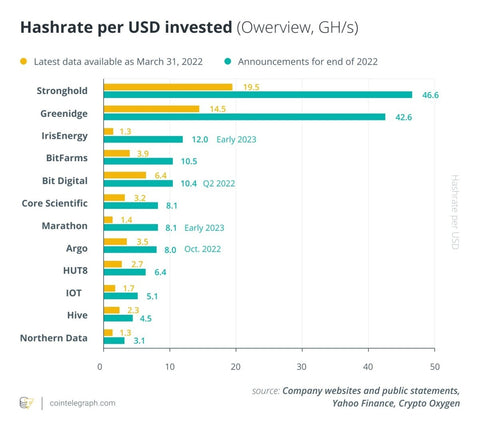Bitcoin miners on exchange only have 17% of the total hashrate

Bitcoin (BTC) mining is one of the most energy-intensive hobbies you can have. That's enough energy to create large-scale mining facilities for this very purpose. Some of these companies are even listed on the stock exchange. This could be beneficial for the reliability and scale of companies. Crypto Oxygen has studied the hashrate that these companies have in common.
17% of total bitcoin computing power
Cointelegraph Research consistently posts beneficial outsider reviews . The examination being referred to comes from Crypto Oxygen and costs USD 900. It depicts exhaustively the way that public diggers address 16.6 % of the complete Bitcoin hashrate.
There are several ways to classify the size of these companies. Crypto Oxygen cites hashrate and miner finances as two examples, but power consumption and efficiency are also important metrics to consider. In absolute terms, Core Scientific is the biggest miner, with 8.3 exahash per second under its control. This generated $545 million in revenue in 2021.Riot Blockchain and Hive Blockchain Technologies held second and third place with $215 million and $195 million in revenue, respectively.
Big investments BTC miners
Fortification is the biggest BTC excavator for contributed capital, with a current hashrate per dollar of 19.5 gigahash each second (per dollar contributed). Greenidge isn't nowhere near here, at 14.5 GH/s per dollar. H ive was really the most beneficial. It is additionally definitely known how enormous the arranged ventures are during the current year. Fortress likewise takes the cake here, which needs to twofold the hashrate contrasted with the aggregate sum contributed.

The hashrate relative to the total investments. Chart courtesy of Cointelegraph.
Additionally, the report provides a picture of each company, including business model data, data center locations, and the size of tokens they hold. This emphasizes that Marathon is lean and mean; relies on third parties for electrical and other infrastructure. Stronghold itself controls the entire value chain, including the electrical infrastructure.
In any case, it is striking that these organizations just control 17% of the absolute hashrate. That isn't a lot, particularly when you look at that as an enormous piece of the rest is in nations that have a less solid base for digital forms of money. For instance, it may be the case that some are still in China and furtively took part in mining.